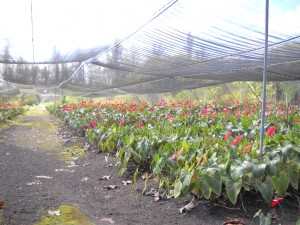Anthurium Pests: Mortal Enemies Of Anthuriums
Anthurium plants are tough, but just as Superman has his weaknesses, so do anthuriums. As long as you follow the basic principles of anthurium care, your plants should be able to shrug off the majority of problems. However, even with the best of care, anthuriums can succumb to the following pests.
Anthracnose is a fungal disease caused by Colletotrichum gloeosporioides. Usually it is not deadly, but it is a great nuisance. When it infects your plants, it causes brown splotches to form on the spadix of your flowers. Sometimes this can cause the spadix to die off completely and start to rot. So if you want nice flowers you need to avoid this disease. You can do this by only raising anthracnose resistant varieties or by using any of a number of fungicides to keep it under control.
Nematodes are small worms that attack the roots of your plants. They burrow into the roots and as they are burrowing they are also feeding on the roots. This causes the roots to grow slower and keeps your plants from growing. They can kill your plants, but more likely will only cause them to be stunted. Fortunately, they can be eliminated with various agricultural chemicals.
Another grave threat is a group of fungi, which include: Pseudomonas, Colletotrichum, Rhizoctonia and Phytophthora. They are essentially parasites that live by consuming your plants. Left unchecked, they are deadly, but there is a lot that you can do to keep them at bay. They like water and low oxygen levels, so do your best to not give them what they want. Your plant likes water too, but just be sure that you don’t water it excessively. And if they are still a problem, any one of a number of fungicides can be used.
By far, the greatest enemy that your plants face is Xanthomonas blight. It is the most diabolical of threats to these plants. It kills nearly all plants that are misfortunate enough to get infected with it. It is a bacteria that is transported from plant to plant by water. If it finds the tiniest scratch on a flower or leaf, it will enter and begin attacking your plant. If you are lucky, you can remove the infected leaf and your plant may live. But if it reaches the core of your plant, the odds of your plant surviving are low. There are no known treatments for blight. It is generally a death sentence for any infected plant.

